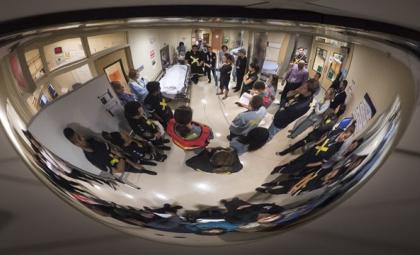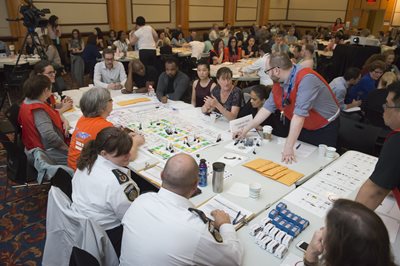“The system itself saved a lot of lives that day”

It’s humbling to hear Claudia Cocco and Rob Burgess speak about the Code Orange (Mass Casualty Incident) called at Sunnybrook Health Sciences Centre during the Toronto van attack. Their teams have been integral in driving a number of critical process improvements around Code Orange at the hospital, yet they credit much of the heroism seen that day to the police, the paramedics, and each hospital that responded to the attack. “The system itself saved a lot of lives that day,” said Burgess.
At the Integrated Risk Management in Health Care Settings conference – hosted by Spark Conferences on October 16 – Cocco and Burgess gave delegates a view inside their world.
Both Cocco and Burgess wear multiple hats. Cocco works as the Emergency Preparedness Coordinator for Sunnybrook and Emergency Preparedness Co-Lead at the Toronto Central LHIN with Burgess. Burgess is also the Director of Patient Flow, Emergency Preparedness and Prehospital Medicine at Sunnybrook.
As an educational supporter of this annual Spark conference, HIROC values the sharing of knowledge and stories about our subscribers’ experiences. It’s these stories that help drive system and safety improvements across healthcare.
On April 23 Sunnybrook was already running at 111% occupancy. The call about a potential mass trauma was received at 1:40 PM. As the closest trauma centre, a Code Orange was declared at Sunnybrook at 1:47 PM.
Shortly after the code was called staff got to work opening the Hospital Emergency Operations Centre and placing the Emergency Department (ED) on lockdown. They also turned off Life or Limb referrals to Sunnybrook. Ontario’s Life or Limb Policy facilitates timely access to acute care services to improve outcomes for patients who are life or limb threatened.
Patients began to arrive at 1:50 PM. Ten patients were sent to Sunnybrook that day. St. Michael’s Hospital, Michael Garron Hospital, and North York General Hospital also received patients.
It’s impossible to be ready for an event as tragic and as close to the community as the van attack was. However, it is possible to train staff and run exercises to ensure everybody knows what their role is should a code be called.
THEY TRAIN FOR THIS
In 2017 Sunnybrook undertook an assessment of their Code Orange process with key stakeholders. They identified several areas for improvement which later led to a complete rewrite of the Code Orange policy.
One of the changes the team implemented was more frequent Code Orange and surge exercises. Their current goal is to have 10 exercises per year – at least four with senior leader involvement. For a three-person Emergency Preparedness Team, this is a major feat and it means that all departments need to play a role.
 During the session, Cocco walked delegates through one of the larger tabletop exercises Sunnybrook has done – a board game-style exercise where pieces represented actual resources. More than 20 departments were engaged in this particular event but they have also held many smaller exercises.
During the session, Cocco walked delegates through one of the larger tabletop exercises Sunnybrook has done – a board game-style exercise where pieces represented actual resources. More than 20 departments were engaged in this particular event but they have also held many smaller exercises.
Another thing Sunnybrook discovered was that regular practice helped alleviate concerns about when to activate the Hospital Emergency Operations Centre, and has improved communication during other incidents. The exercises have also allowed participants to see if any gaps exist in team communication.
The knowledge they gathered and the measures they took – from the initial assessment to the staff exercises – played a part in their response to the events of April 23 and healing the community afterward.
LESSONS LEARNED AFTER APRIL’S CODE ORANGE
Cocco and Burgess know how important it is to review codes and take away information that can improve their processes in the future. They also know how important it is to share these lessons more broadly, thus they offered delegates a few of their key takeaways from the hospital’s response on April 23.
- Ensure the patient registration process during emergency codes is: easy to use, familiar, and starts at the door.
- Always set up a Family Information and Support Centre. It’s impossible to predict the number of relatives, friends, and families who will be looking for someone.
- Ensure there is connectivity between the ED, the Hospital Emergency Operations Centre, and the Family Information and Support Centre.
- Give staff time to recover and recalibrate after major events before resuming normal operations.
- Set up regular practice exercises.
One unexpected innovation that came out of the Code Orange on April 23 was the development of an electronic whiteboard for patient tracking during codes. At the time, Sunnybrook was using physical whiteboards and had runners copying information between them. Cocco says a member of their IT team was simply observing this process and has since begun developing an electronic whiteboard that anyone can access at any time.
For Sunnybrook, these lessons and the reviews they have done this year can only strengthen their Code Orange process going forward. The fact that tragic events seem to be happening at an increased rate in our communities makes the practice and the exercises all the more vital. As Cocco and Burgess alluded to – each hospital and provider must do their part, but it’s the system as a whole that saves lives.
By Michelle Holden, Communications & Marketing Specialist, HIROC